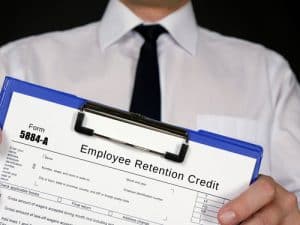Ready to apply for the Employee Retention Credit? Here's everything you need to know about completing your ERC application..

On 1/10/24, IRS Commissioner Daniel Werfel announced that the IRS is continuing to improve and automate ERC review procedures and will begin processing new ERC claims in the spring following the moratorium implemented in September. Existing claims are still being processed and eligible businesses can still submit an ERC claim through reputable ERC companies to be processed when the moratorium ends. Visit our full breakdown of the ERC pause for the latest information.
The Employee Retention Tax Credit is making waves in the small business world, putting money back into the pockets of small business owners affected by the COVID-19 pandemic. If you qualify for this money-saving tax credit but don’t know how to apply for ERC, you’re in the right place.
In this post, we’ll show you how to apply for the employee retention credit correctly. Keep reading to learn the two methods for claiming your credit, how to fill out your ERC application, when to submit your ERC application by, and everything else you need to know to get for your ERC refund.
If you’re pressed for time and don’t want to engage in the application process yourself, take a look at our best companies for ERC credit filing. We’ve researched and short-listed several companies that specialize in ERC applications and can handle the entire process for you.
What Is The ERC Stimulus?
The ERC stimulus is also known as the Employee Retention Tax Credit, ERTC, or ERC. This refundable tax credit was created under the CARES Act in 2020 to incentivize businesses for keeping their staff on payroll during the economic shutdown.
While this program has ended, eligible small businesses can still retroactively claim the credit for qualified wages paid in 2020 and 2021. Eligible businesses may receive up to $5,000 per employee paid in 2020 and as much as $21,000 per employee paid in 2021.
This program has since ended, but you can still claim the 2020 ERC until April 15th, 2024, and the 2021 ERC until April 15th, 2025. The ERC can be claimed for wages paid in 2020 can be as high as $5,000 per employee, and the ERC for wages paid in 2021 can be as high as $21,000 per employee.
Can I Apply For ERC?
Qualifying for the ERC stimulus tax credit requires business owners to meet several requirements. In short, businesses that weren’t affected by COVID-19 economic shutdowns will not qualify for this stimulus option.
Before applying for the ERC, review the employee retention credit requirements to determine if your business qualifies.
How To Apply For The Employee Retention Credit
There are two options for applying for the ERC credit: you can file the proper forms yourself or hire an ERC professional.
ERC Application Option #1: Apply For The ERC Yourself
The first option is to fill out your ERC application yourself in order to claim your ERC refund. The pros and cons of calculating, filing, and applying for the ERC credit without professional help are:
Pros
- More affordable than hiring a professional
- Free guidance available online
Cons
- More room for error
- Potential for miscalculating your refund
- Time consuming
If you opt to go the do-it-yourself route, you will fill out IRS Form 941-X to amend your quarterly tax returns from 2020 and 2021. Filling out these forms is a complicated and time-consuming process. Before even filing your forms, you’ll need to understand your eligibility and how to calculate your ERC. It’s important to accurately calculate your ERC, as miscalculating can result in repaying ERC funds, penalties, and interest.
Fortunately, there are plenty of online resources, including the official IRS website, that offer guidance and step-by-step checklists to help you claim your ERC. Other resources include ERC calculators, but use these with caution, as they only provide estimates. Actual refund amounts may vary.
ERC Application Option #2: Apply For The ERC Through An ERC Service
While you can file the ERC credit on your own, hiring an accountant or using a reputable ERC funding company can save you time and ensure that everything is done correctly. Here are the pros and cons of hiring someone to file your ERC claim for you:
Pros
- Saves time
- More accurate
- Increased peace of mind
- Higher likelihood of maximizing your ERC refund
Cons
- More expensive
- Requires trusting a third party with sensitive tax information
If you choose to hire a professional, you gave several options available, including using a CPA or hiring a company that specializes in ERC funding to handle calculating your ERC refund and filing your tax forms.
Financial and lending companies such as Lendio offer ERC services to business owners. You can learn more by applying for the ERC with Lendio.
Most companies offering these services have partnered with a network of professionals who have extensively studied ERC and have a full understanding of the tax credit. Working with one of the best ERC companies alleviates the stress of claiming the ERC, provides peace of mind knowing that the correct forms are being filed, and eliminates the time spent calculating refunds and filling out tax forms. Some companies even provide audit protection.
Hiring a pro isn’t without its downsides. Fees for ERC services can be expensive — generally 15% to 25% of your refund amount. You’ll also have to find a reputable business or tax pro, as you’ll be entrusting them with sensitive tax information. Despite these two relatively mild downsides, it might be worth spending the extra money to make sure you don’t miss out on this potentially lucrative opportunity because of a mistake on a form.
When are ERC Applications Due?
To apply for the ERC credit for 2020, your amended tax return must be submitted to the IRS by April 15, 2024. To apply for the ERC credit for 2021, the deadline is April 15, 2025.
Is There An ERC Application Form?
If you are claiming the ERC yourself, you’ll need to fill out IRS Form 941-X. A separate form is required for each quarter for which you’re claiming the credit.
If you are using a third-party ERC company, most businesses offer a free analysis to determine if you qualify for ERC. By filling out a short form, you can determine if you qualify. If you opt to move forward, a lengthier application process may follow.
How To Apply For The ERC In 5 Steps
If you choose to hire a professional to claim the ERC on your behalf, we’ve broken down the general process into five easy-to-understand steps.
Step 1: Determine Your Eligibility For The ERC
Before starting an application, you need to determine if your business is eligible for the ERC.
Businesses that paid employees in 2020 and 2021 may be eligible for ERC if one of the following conditions is met:
- Your business was shut down due to a governmental order during any part of 2020 and/or parts of 2021 OR
- Your business experienced a significant decline in gross receipts during the qualifying periods
Many ERC companies offer questionnaires to help you determine if your business is eligible for the ERC. Additionally, some companies offer a free analysis to determine the amount you may be eligible to receive.
Step 2: Gather Your ERC Application Documentation
Once you’ve determined your eligibility for an ERC refund, you’ll need to provide the ERC company with documentation. This may include:
- Tax returns from 2020 and 2021
- Payroll records from 2020 and 2021
- Records showing profits from 2019 to 2021
- Employee records from 2019 to 2021
In most cases, you’ll be able to easily upload all documentation through a secure online portal.
Step 3: Fill Out The ERC Application
Once you’ve decided to use a professional to claim your ERC refund, make sure to read through the terms and conditions and understand all fees before moving forward in the process.
The first step is to fill out an eligibility form. This is a quick form that requires basic information about yourself and your business. Most companies offer this option for free. If the ERC company determines you’re eligible, they’ll be in contact with you to provide information such as the amount of your refund and their fee schedule.
If you move forward with claiming your ERC, you will provide the required documentation to the ERC company. Additional documentation and information may be required, so make sure to stay in contact with the ERC company throughout the process.
Once all information has been received the company will prepare your 941-X forms to submit to the IRS. You will be required to review and sign these forms before they are submitted. Take the time to ensure that all information looks accurate, as even a small error can delay processing.
Step 4: Check The Status Of Your ERC Application
Staying in touch with your ERC professional is important throughout the application process to keep everything moving smoothly. Make sure to provide updated contact information. Turn your phone ringer on and add the company’s phone number to your contacts to avoid unintentional missed or blocked calls. Add the company’s email address to your contacts and check your inbox daily to send additional documents and information if needed.
The ERC professional you’ve hired should keep you up-to-date throughout the process. However, if you need assistance, don’t hesitate to reach out. Note that if you’re looking to find out when your refund will be issued, this information may not be available.
Step 5: Receive Your Employee Retention Credit Refund
Once your amended forms have been submitted to the IRS, the final step is to wait for your ERC refund from the IRS.
Unfortunately, there is a lengthy waiting period for ERC refunds. Some businesses have received their refunds in as little as four months, while others may have to wait 12 months or even longer. Depending on what ERC company you worked with, you may be required to pay your fee after you have received your refund check in the mail.
If you’d rather not wait this long, you can get an advance payment of your ERC funds by applying for an ERC loan. Our list of the best ERC loans is a great place to find a lender and get your ERC funds in weeks instead of months.
The Bottom Line On Applying For The ERC
While applying for the ERC can be daunting, it is a great way to pay yourself back for keeping your employees on payroll during the COVID-19 economic shutdowns. Take some of the stress out of a potentially overwhelming process and consider hiring a professional to help you apply for the ERC. Or, after doing your research, you may feel capable of handling your ERC claim yourself (and saving money while doing it).
Take the information and steps we’ve provided you and start the process of applying for the ERC today. We have several other articles that can help if you have more questions concerning the ERC or want to share the information with your network.
Once you’ve applied for the employee retention tax credit yourself or through a specialist like Omega Accounting, learn how to check the status of your ERC refund and claim the ERC on your taxes.
ERC Application FAQs
Is applying for ERC worth it?
Applying for the ERC tax credit is absolutely worth it! If your business meets the ERC qualifications, you can receive a refund potentially worth thousands of dollars.
When are ERC applications due?
If you qualify for the employee retention credit, you have until April 15, 2024, to claim the ERC credit for 2020 and until April 15, 2025, to claim the ERC credit for 2021.
If you’re working with a third-party ERC company or accountant, make sure that you understand the deadlines for submitting information and documentation. These professionals may require several weeks in order to accurately calculate your refund, fill out forms, and submit them to the IRS by the deadlines listed above.
How do you apply for ERC?
You can apply for the ERC by hiring an ERC company or by calculating your ERC credit and filling out Form 941-X to submit to the IRS.
Is the ERC application difficult?
Calculating the ERC tax credit and filling out your ERC application isn’t impossible but can be difficult if you choose to do the process alone. There are ERC companies that you can hire to handle your ERC application for you for a fee.
What is the ERC stimulus?
The ERC stimulus, or employee retention credit, is a tax break for small business owners who were affected by the coronavirus pandemic. Businesses affected by COVID-19 shutdowns that continued to pay employees may be eligible for this refundable tax credit.
Can I still apply for the employee retention tax credit?
Yes, you can still apply for the employee retention credit. For qualified wages paid in 2020, you have until April 15th, 2024, to submit your amended return to the IRS. For qualified wages paid in 2021, you have until April 15th, 2025, to submit your return.












